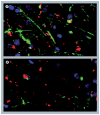Neuronal toxicity in HIV CNS disease
- PMID: 23616788
- PMCID: PMC3632417
- DOI: 10.2217/fvl.12.57
Neuronal toxicity in HIV CNS disease
Abstract
HIV enters the brain during the early stages of initial infection and can result in a complicated array of diverse neurological dysfunctions. While neuronal injury and loss are at the heart of neurological decline and HIV-associated neuropathology, HIV does not productively infect neurons and the effects of HIV on neurons may be described as largely indirect. Viral proteins released from infected cells in the CNS are a well-characterized source of neuronal toxicity. Likewise, host-derived inflammatory cytokines and chemokines released from infected and/or activated glial cells can damage neurons, as well. Newly identified host-virus interactions and the current state of our knowledge regarding HIV-associated neuronal toxicity will be addressed in this review. Aspects of HIV-associated neurotoxic mechanisms, patterns of neuronal damage, viral effects on neurotrophic signaling, clade variations and comorbid substance abuse will be discussed. Recent advances in our understanding of the impact of HIV infection of the CNS on neuronal dysfunction and cell death will also be highlighted.
Keywords: CNS; HIV-associated neurocognitive disorders; blood–brain barrier; cART; excitotoxicity; inflammation; neurons; synaptodendritic.
Figures



References
-
- Stevenson M. HIV-1 pathogenesis. Nat Med. 2003;9(7):853–860. - PubMed
-
- Gorry PR, Ancuta P. Coreceptors and HIV-1 pathogenesis. Curr HIV/AIDS Rep. 2011;8(1):45–53. - PubMed
-
- Fauci AS. Host factors and the pathogenesis of HIV-induced disease. Nature. 1996;384(6609):529–534. - PubMed
-
- Lavi E, Kolson DL, Ulrich AM, Fu L, Gonzalez-Scarano F. Chemokine receptors in the human brain and their relationship to HIV infection. J Neurovirol. 1998;4(3):301–311. - PubMed
Grants and funding
LinkOut - more resources
Full Text Sources
